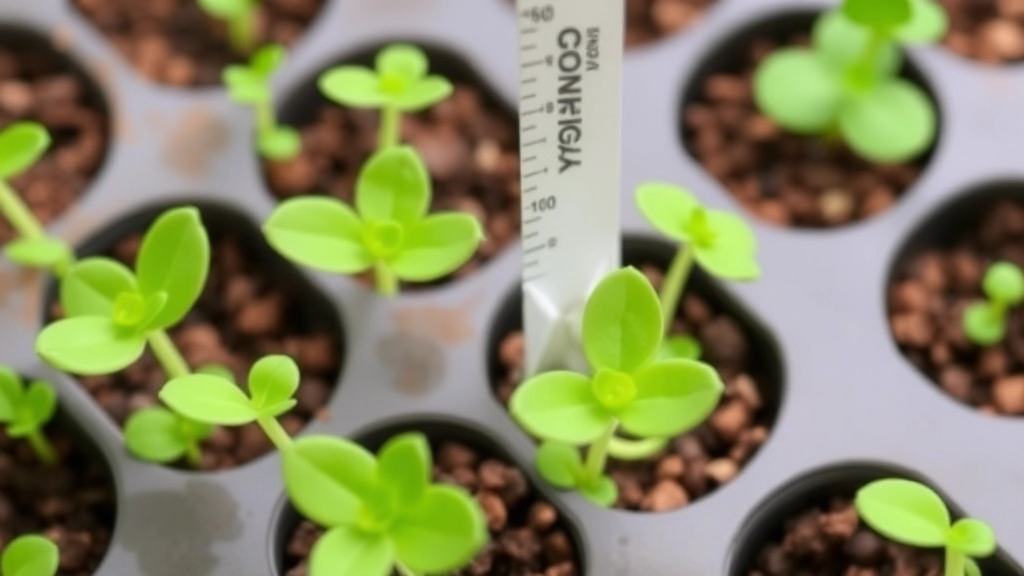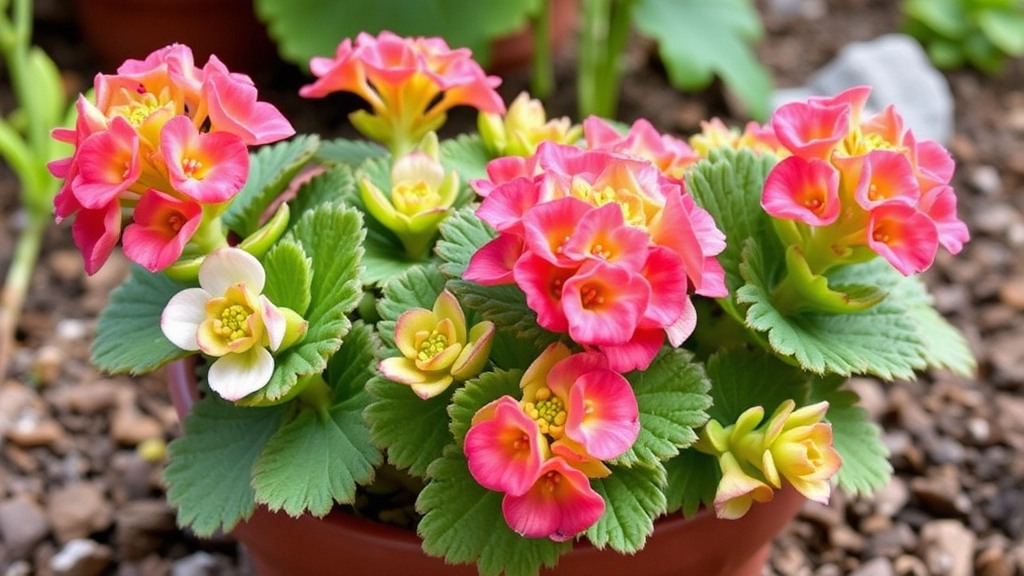Care for the Kalanchoe Mother of Thousands
Ever wondered how to care for the Kalanchoe Mother of Thousands? This fascinating succulent, with its unique leaf-borne plantlets, is a favourite among gardening enthusiasts. Whether you’re curious about its rapid propagation or looking for tips to manage its spread, you’ve come to the right place. Let’s dive into the essential care requirements to keep your plant thriving.
Light and Temperature Conditions
Understanding the ideal light and temperature conditions is crucial for the healthy growth of your Mother of Thousands. Pair that with the best soil and watering practices, and you’ll have a thriving succulent in no time.
Propagation and Management
Plus, I’ll share some handy tips on propagating new plants from those adorable plantlets and managing its invasiveness. Ready to become a pro at caring for this unique plant? Let’s get started!
Essential Care Requirements for Mother of Thousands
Are you struggling to keep your Mother of Thousands thriving? You’re not alone. Many succulent enthusiasts face challenges in providing the right care for this unique plant.
To ensure your Mother of Thousands flourishes, it’s vital to focus on a few essential care requirements. Here’s a straightforward guide to help you succeed:
Light Conditions
- Bright, Indirect Light: Your Mother of Thousands loves bright, indirect sunlight. Too much direct sun can scorch its leaves, while too little light can stunt its growth.
- Rotating the Plant: Regularly rotate your plant to ensure even light distribution, promoting balanced growth.
Temperature Preferences
- Warm Temperatures: This succulent thrives in temperatures ranging from 20°C to 30°C (68°F to 86°F).
- Avoid Frost: Protect it from cold drafts and frost, as it is sensitive to low temperatures.
Humidity Levels
- Low to Moderate Humidity: Mother of Thousands prefers low humidity levels. Ensure good air circulation around the plant to prevent issues.
Fertilization Needs
- Minimal Fertilizer: Fertilize sparingly during the growing season (spring and summer) using a diluted succulent fertilizer. Avoid over-fertilizing, as this can harm the plant.
For more detailed tips on growing and caring for similar succulents, check out our guide on Kalanchoe Delagoensis and the Mother of Millions care guide.
Ideal Light and Temperature for Healthy Growth

Have you ever wondered why your Mother of Thousands isn’t thriving like you’d hoped?
Light and temperature play a massive role in keeping these plants happy.
Light Needs
Mother of Thousands love bright, indirect sunlight.
Here’s how to get it just right:
- Direct Sunlight: Too much can scorch the leaves.
- Indirect Light: A spot near a window with filtered light is perfect.
- Supplemental Light: If you’re in a low-light area, consider a grow light.
Temperature Preferences
These succulents are pretty chill when it comes to temperature, but here’s what you should know:
- Ideal Range: They thrive between 20°C to 30°C (68°F to 86°F).
- Cold Sensitivity: Anything below 10°C (50°F) can stress them out.
- Avoid Drafts: Keep them away from cold drafts or sudden temperature changes.
Quick Tips for Success
- Monitor Light Levels: Check how light changes throughout the day and adjust accordingly.
- Watch for Signs: If leaves start to stretch, they might need more light. If they turn brown, it could be too much sun.
Best Soil and Watering Practices for Succulents
As we delve deeper into the care of your Mother of Thousands, understanding the right soil and watering practices is crucial for its thriving growth. Many plant enthusiasts often struggle with finding the balance in these areas.
Choosing the Right Soil
The ideal soil for succulents, including Mother of Thousands, needs to be well-draining to prevent root rot. Here are some key points to consider:
- Cactus or Succulent Mix: Opt for a pre-made cactus or succulent mix, which typically contains sand, perlite, and peat.
- DIY Mix: You can create your own by combining:
- 2 parts potting soil
- 1 part coarse sand
- 1 part perlite or pumice
This combination ensures that water drains efficiently while retaining some moisture for the plant.
Watering Practices
Watering can be a source of confusion for many succulent owners. Here’s how to do it right:
- Frequency: Water your Mother of Thousands only when the top inch of soil is dry. This usually translates to every 2-3 weeks, but it can vary based on the season and your home’s humidity.
- Deep Watering: When you do water, soak the soil thoroughly until water drains from the bottom. Avoid letting the plant sit in standing water.
- Signs of Overwatering: Keep an eye out for yellowing leaves or mushy stems, which are indicators that you might be overdoing it.
For more detailed instructions on how to plant your Mother of Thousands, check out our step-by-step guide. Additionally, if you’re looking to propagate this beautiful plant, our complete guide to Mother of Thousands care and propagation is a must-read.
Propagation Tips: Growing More Plants from Plantlets

Are you looking to expand your collection of Mother of Thousands?
This succulent is not just beautiful; it’s also incredibly easy to propagate.
The plantlets that form along the edges of the leaves are your ticket to creating new plants.
Here’s how to make the most of this unique propagation method:
Step-by-Step Propagation Process
- Identify Healthy Plantlets
Look for plump, green plantlets that are at least a couple of inches long.
Avoid any that appear shrivelled or discoloured. - Carefully Remove Plantlets
Gently twist or cut the plantlets from the mother plant using clean scissors.
This helps prevent any damage to both the parent and the new plant. - Let Them Callous
Place the removed plantlets on a dry surface for a day or two.
This allows the cut end to callous over, reducing the risk of rot. - Prepare the Soil
Use a well-draining soil mix, ideally one designed for succulents.
This will ensure that the plantlets have the right environment to thrive. - Plant the Plantlets
Once calloused, gently place them in the soil, ensuring the cut end is buried.
Water lightly to settle the soil around them. - Provide Proper Care
Keep the newly planted plantlets in bright, indirect light.
Water sparingly until you see new growth, indicating that roots are forming.
Tips for Success
- Timing is Key: The best time to propagate is during the growing season (spring and summer).
- Humidity Matters: If your environment is dry, consider using a humidity dome to retain moisture.
- Patience Pays Off: It may take a few weeks for roots to develop, so don’t rush the process.
By following these steps, you can easily grow a whole new set of Mother of Thousands plants to share with friends or fill your home with greenery.
Managing Invasiveness: Containing Mother of Thousands
Many plant enthusiasts often wonder how to manage the invasiveness of Mother of Thousands. This succulent, while beautiful, can quickly take over your garden or indoor space if not properly contained.
Understanding Invasiveness
Mother of Thousands (Kalanchoe daigremontiana) is known for its ability to produce numerous plantlets along its leaves. These plantlets can easily root and spread, leading to an overabundance of plants. Here are some strategies to keep this plant in check:
- Regular Pruning: Trim back the plant regularly to prevent it from becoming too leggy and to control the number of plantlets produced.
- Use Barriers: Consider planting Mother of Thousands in pots or raised beds. This can help contain its spread and make management easier.
- Monitor Plantlets: Keep an eye on the plantlets that drop. Remove them promptly to prevent them from taking root in unwanted areas.
- Limit Outdoor Planting: If you’re growing it outside, choose a controlled environment or a designated area where it can’t escape easily.
Safe Disposal
When pruning or removing plantlets, dispose of them responsibly:
- Compost Carefully: Avoid composting plantlets unless you’re sure they won’t root. Instead, discard them in a sealed bag.
- Avoid Overplanting: Limit how many you plant in one area to prevent overcrowding and competition for nutrients.
By implementing these strategies, you can enjoy the beauty of Mother of Thousands without the worry of it becoming invasive. For more detailed information, check out our Mother of Thousands care guide and our complete guide to growing Kalanchoe Mother of Thousands.
Common Issues and How to Solve Them (Pests, Diseases, Overwatering)

So, you’ve got your Mother of Thousands thriving, but what if things start to go sideways?
Let’s chat about some common issues that might pop up and how to tackle them head-on.
Pests
Pests can be a real pain, can’t they?
Common culprits include:
- Mealybugs: These little white fluff balls love to hide in the nooks of your plant.
- Spider mites: Tiny and sneaky, they can cause webbing and yellowing leaves.
- Aphids: Small but mighty, they suck the sap right out of your plant.
How to handle them:
- Soap solution: Mix water with a few drops of dish soap and spray it on affected areas.
- Neem oil: A natural pesticide that works wonders.
- Isolate: If you spot pests, move the plant away from others to prevent spreading.
Diseases
Next up, diseases.
Even the hardiest plants can fall victim to fungal infections or root rot.
Signs to watch for:
- Yellowing leaves: This could mean overwatering or a nutrient deficiency.
- Brown spots: Often a sign of fungal issues.
Solutions:
- Good air circulation: Make sure your plant isn’t cramped.
- Remove affected leaves: Trim away any sick parts to prevent spreading.
- Repot: If root rot is suspected, it might be time to repot in fresh, dry soil.
Overwatering
Ah, the classic overwatering trap.
It’s so easy to do, especially when you want to pamper your plant.
Signs of overwatering:
- Mushy leaves: If they feel soft or squishy, it’s a red flag.
- Yellowing leaves: This can also indicate too much water.
Prevention and correction:
- Check your soil: Always let it dry out between waterings.
- Drainage: Ensure your pot has proper drainage holes.
- Skip a watering: If in doubt, hold off for a bit longer.
By keeping an eye out for these issues and acting swiftly, you can keep your Mother of Thousands healthy and happy.
Potting and Repotting: When and How to Repot Your Plant
Have you ever wondered when the right time to repot your Mother of Thousands is?
Repotting is a crucial aspect of maintaining the health of your succulent.
When to Repot Your Mother of Thousands
- Signs of Root Bound: If you notice roots growing out of the drainage holes or circling around the pot, it’s time to repot.
- Growth Stagnation: If your plant seems to have stopped growing, it may need more space.
- Soil Degradation: If the soil appears compacted or has lost its nutrients, a fresh mix can do wonders.
How to Repot Your Plant
- Choose the Right Time: Early spring is ideal, just before the growing season kicks in.
- Select a New Pot: Opt for a pot that is 1-2 inches larger in diameter than the current one. Ensure it has drainage holes.
- Prepare the Soil: Use a well-draining succulent mix. You can also add perlite or sand for extra drainage.
- Remove the Plant: Gently take your Mother of Thousands out of its current pot. Be careful not to damage the roots.
- Inspect the Roots: Trim any dead or rotting roots with clean scissors.
- Place in New Pot: Position your plant in the new pot, filling in around it with fresh soil. Ensure the plant is at the same depth as before.
- Water Sparingly: After repotting, wait a week before watering to allow the roots to settle.
Repotting your Mother of Thousands not only helps promote healthy growth but also allows you to refresh the soil and nutrients. For more details on how to care for your succulent, check out our Complete Guide to Kalanchoe Mother of Thousands Care & Propagation. Additionally, if you’re interested in the different varieties of this plant, visit our Kalanchoe Mother of Thousands Varieties & Care Guide.
FAQs on Kalanchoe Mother Of Thousands
What is the ideal light for Mother of Thousands?
Mother of Thousands thrive in bright, indirect sunlight. Direct sunlight can scorch the leaves, so placing them near a window with filtered light is ideal. If you’re in a low-light area, consider using a grow light.
What temperature range is best for these succulents?
These plants prefer temperatures between 20°C to 30°C (68°F to 86°F). They are sensitive to cold and can become stressed at temperatures below 10°C (50°F). Avoid placing them in areas with cold drafts or sudden temperature changes.
How can I propagate Mother of Thousands?
Propagation is simple with the plantlets that form along the edges of the leaves. Carefully remove healthy plantlets, let them callous, and then plant them in well-draining soil. Keep them in bright, indirect light and water sparingly until new growth appears.
When is the best time to propagate my plant?
The best time to propagate Mother of Thousands is during the growing season, which is typically in spring and summer. This ensures optimal conditions for new growth.
What are common pests that affect Mother of Thousands?
Common pests include mealybugs, spider mites, and aphids. These pests can be managed using a soap solution, neem oil, and by isolating the affected plant to prevent the spread.
How do I know if my plant has a disease?
Signs of disease include yellowing leaves, which could indicate overwatering or nutrient deficiency, and brown spots, often a sign of fungal issues. Ensure good air circulation, remove affected leaves, and consider repotting if root rot is suspected.
How can I prevent overwatering my Mother of Thousands?
To prevent overwatering, let the soil dry out between waterings and ensure your pot has proper drainage holes. If you’re unsure, it’s better to skip a watering session. Signs of overwatering include mushy or yellowing leaves.
What should I do if I notice pests on my plant?
If you notice pests, use a soap solution or neem oil to treat the affected areas. Additionally, isolate the plant from others to prevent the pests from spreading.
How can I improve the humidity for my plantlets?
If your environment is dry, consider using a humidity dome to retain moisture around the newly planted plantlets. This can help in their initial growth phase.
Why are the leaves of my Mother of Thousands turning brown?
Browning leaves can be a sign of too much direct sunlight. Adjust the plant’s position to ensure it receives bright, indirect light instead.
References
-
Mother of Thousands Plant Profile – The Spruce
-
Mother of Thousands Care and Growing Guide – Gardening Know How
-
Mother of Thousands – House Plants Expert
